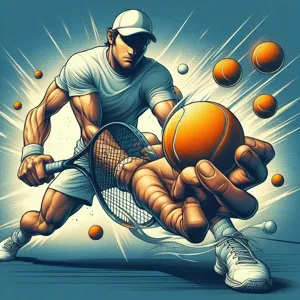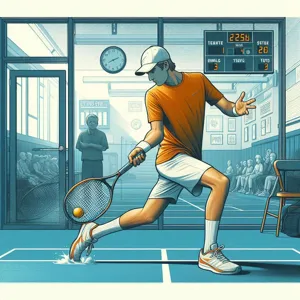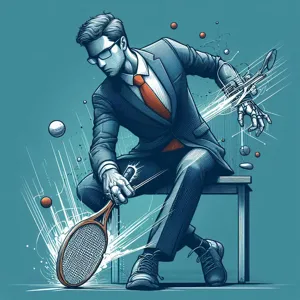Tennis is a game of finesse, strategy, and precision, and mastering the backhand slice can elevate your performance from ordinary to exceptional.
This essential shot not only adds variety to your gameplay but also serves as a powerful tool for outsmarting your opponents. Whether you’re battling it out on the court or simply looking to refine your skills, understanding the intricacies of the backhand slice will give you a competitive edge. In this ultimate guide, we’ll delve into the mechanics of the slice, explore the nuances of grip and stance, and provide actionable tips and drills to help you perfect this vital shot. Join us as we unlock the secrets to mastering the slice, allowing you to command the court with confidence and style. Get ready to transform your backhand into a formidable weapon that keeps your opponents guessing and enhances your overall game!
1. Understanding the Backhand: Types and Techniques

The backhand is a crucial stroke in tennis, often regarded as the backbone of a player’s game. Understanding the different types of backhands and the techniques involved is essential for mastering this pivotal shot. Broadly, backhands can be classified into two main categories: the one-handed backhand and the two-handed backhand, each offering distinct advantages and requiring specific skills.
### One-Handed Backhand
The one-handed backhand is characterized by its elegant simplicity. Players often admire this stroke for its aesthetic appeal and the ability it gives to generate powerful topspin or flat shots. To execute a one-handed backhand effectively, players must focus on grip and timing. The Eastern or Continental grip is commonly used, allowing for greater slice and finesse. As you prepare for the shot, ensure your non-dominant hand is guiding the racquet back, while your dominant hand provides the force during the swing. This stroke can be particularly effective for reaching balls hit wide to your forehand side, enabling you to hit with precision and control. However, it requires excellent footwork and balance, as the swing is longer and more open to error compared to its two-handed counterpart.
### Two-Handed Backhand
In contrast, the two-handed backhand provides a more stable base, making it a popular choice among modern players. This technique allows for increased power and consistency, as both hands work in harmony to generate a solid stroke. The most common grip for the two-handed backhand is a combination of the Eastern grip with the dominant hand and the Semi-Western grip with the non-dominant hand. As you prepare for the shot, both hands should move back together, allowing for a compact and controlled swing. The two-handed backhand excels in defensive situations, providing players with the ability to absorb power from their opponent’s shots and return them with equal force.
### Key Techniques for Mastery
Regardless of which backhand style you choose, mastering a few key techniques will elevate your game. Begin by ensuring that your grip is comfortable and allows for quick adjustments. Focus on your footwork, as being in the right position is essential for executing a clean shot. Practice your follow-through, which should be smooth and directed toward your target, allowing for greater accuracy and spin. Additionally, consider incorporating drills that emphasize timing and rhythm, helping you to develop muscle memory and confidence in your backhand stroke.
Understanding the nuances of both the one-handed and two-handed backhand will provide a solid foundation for your tennis game. By honing your skills and experimenting with different techniques, you can unlock the full potential of this essential stroke and elevate your overall performance on the court. Whether you’re aiming for precision, power, or a combination of both, mastering the backhand is a step towards becoming a formidable tennis player.
2. The Mechanics of a Perfect Backhand Slice
The backhand slice is one of the most versatile shots in a tennis player’s arsenal, combining finesse with strategic depth. Understanding the mechanics behind a perfect backhand slice is crucial for both beginners looking to elevate their game and seasoned players aiming for precision.
To initiate the shot, positioning is key. Start by aligning your body sideways to the net, with your non-dominant shoulder facing your opponent. This stance not only allows for better balance but also sets the stage for a fluid motion. As the ball approaches, step forward with your non-dominant foot, creating a solid platform for your swing.
Grip is another essential element. The backhand slice is typically executed using the continental grip, which allows for better wrist action and control. This grip enables you to cut under the ball, imparting the necessary backspin. As you prepare to strike, keep your eyes locked on the ball, ensuring you can judge its trajectory and speed.
As you swing, focus on a smooth, downward motion. The ideal trajectory involves making contact with the ball slightly below its equator, which will generate that characteristic slice spin. Your racket should follow through low and across your body, finishing with the racket head pointing towards your opposite shoulder. This follow-through not only helps maintain control but also ensures the shot stays low, making it challenging for your opponent to respond with a powerful return.
Finally, practice is vital. Repeatedly working on your slice in drills will refine your timing and technique. Whether you’re slicing to set up a volley at the net or to push your opponent back behind the baseline, mastering these mechanics will enhance your overall game and provide you with an edge on the court. Remember, the backhand slice is not just a defensive shot; when executed correctly, it can be a strategic weapon in your tennis toolkit.
3. Grip Choices: Finding the Right Handle for Your Slice

When it comes to mastering the slice in tennis, the grip you choose is a critical element that can significantly influence your shot’s effectiveness. The right grip not only enhances your control and spin but also sets the foundation for a powerful backhand slice. While there are several grip choices to consider, two stand out for their effectiveness: the Eastern grip and the continental grip.
The **Eastern grip**, often favored by players who prefer a more traditional approach, involves placing the base knuckle of your index finger on the third bevel of the racket handle. This grip allows for a clean, flat strike, making it easier to generate depth and precision. It provides an excellent balance between control and spin, allowing players to execute a slice with finesse. When using the Eastern grip for your backhand slice, aim to brush up on the ball with a slight angle, creating that desirable backspin that keeps your opponent on their toes.
On the other hand, the **continental grip** is a popular choice among many advanced players due to its versatility. To achieve this grip, you place the base knuckle of your index finger on the second bevel. This grip is particularly effective for executing a slice because it allows for a natural wrist motion, enabling you to create a higher level of spin and a more pronounced angle. The continental grip also seamlessly transitions between different shots, making it a favorite for volleys and serves, which can be beneficial during fast-paced matches.
Experimenting with both grips will help you discover which feels more comfortable and natural for your playing style. Remember, the goal is to create a slice that not only cuts through the air but also challenges your opponent with its unpredictability. Whichever grip you choose, be sure to practice consistently, as muscle memory plays a vital role in your ability to execute a flawless backhand slice under pressure. With the right grip in hand, you’ll be well on your way to mastering the intricate art of slicing in tennis.
4. Footwork Fundamentals: Positioning for Success
Footwork is the unsung hero of a successful backhand in tennis. While many players focus solely on the swing mechanics, it’s often the player’s positioning that ultimately determines the effectiveness of their shot. Mastering your footwork allows you to get into the optimal stance to execute a powerful and precise backhand, transforming a good shot into a great one.
To begin, envision the court as a dynamic landscape that requires constant adjustment. As the ball approaches, your first instinct should be to pivot and move quickly, using small, agile steps to position yourself behind the ball. It’s crucial to maintain a low center of gravity, bending your knees slightly as you approach the shot. This stance not only enhances your stability but also prepares your body to generate the power needed for that perfect backhand.
One key aspect to focus on is the split step—a quick hop you take just as your opponent makes contact with the ball. This action allows you to spring into motion, enabling faster reactions to varying shot placements. From this position, you’ll want to push off your back foot, transferring your weight forward as you prepare to strike. Remember, the relationship between your feet and the racquet is symbiotic; the better your footwork, the more effectively you can engage your core and upper body to deliver a powerful shot.
Finally, practice moving laterally and diagonally. The backhand is often hit on the run, requiring you to be adept at positioning yourself efficiently, regardless of the ball’s path. By incorporating footwork drills into your training regimen, you’ll build muscle memory that will serve you well during matches, allowing you to glide effortlessly across the court. When your footwork is dialed in, not only will your backhand shine, but you’ll also find your overall game elevated as you gain confidence in your ability to move and strike with precision.
5. The Importance of Timing in a Backhand Slice

Timing is crucial when it comes to executing a backhand slice, and mastering this aspect can elevate your game to a whole new level. Unlike flat shots that rely on power, the backhand slice is all about finesse, control, and precision. To achieve this, you must synchronize your movements with the ball’s trajectory, ensuring that you make contact at just the right moment.
As the ball approaches, focus on its height and speed. Ideally, you want to strike the ball when it’s around waist height, allowing for maximum control and spin. If you hit too early, you risk sending the ball sailing long; too late, and you may find yourself on the defensive, unable to generate the desired slice. The key is to anticipate the ball’s bounce and adjust your positioning accordingly.
Moreover, your footwork plays a vital role in timing. Quick, agile steps will enable you to position yourself optimally, creating a stable base from which to execute the slice. As you prepare to strike, use your non-dominant hand to guide your racket into the right position, while your dominant hand focuses on the slice motion itself.
When you finally make contact, think about the follow-through. A smooth, fluid motion not only enhances the quality of your shot but also helps with timing for your next move. Practicing this rhythm will train your body to instinctively react, ensuring that your backhand slice becomes a reliable weapon in your arsenal. By honing your timing, you’ll not only improve the effectiveness of your slice but also maintain a competitive edge on the court.
6. Practicing Your Slice: Drills and Exercises
Practicing your slice is essential for mastering this versatile shot in tennis, and incorporating specific drills and exercises into your training routine can significantly improve your technique and consistency. Here are some effective ways to refine your slice and add it to your arsenal:
**1. Wall Drills:** Begin by finding a wall or a rebounder. Stand a few feet away and practice hitting slices against it. Focus on the motion of your racket as you brush down the back of the ball, generating the necessary spin. Aim for specific targets on the wall to enhance your accuracy. This drill not only helps with your slice technique but also improves your hand-eye coordination.
**2. Partner Drills:** Team up with a practice partner and take turns hitting slices back and forth. Start at the net, where you can focus on the precision and placement of your shots. As you become more comfortable, move back to the baseline and practice hitting deeper slices. Encourage your partner to return shots with varying speeds and spins to simulate real match conditions, allowing you to adjust and adapt your slice as needed.
**3. Target Practice:** Set up cones or targets on the court at various locations. Practice slicing the ball to these targets, emphasizing different angles and depths. This drill encourages you to control the placement of your slice and helps you learn how to use it strategically during a match.
**4. High-to-Low Swing Path Drills:** To master the mechanics of your slice, practice the high-to-low swing path by tossing the ball in the air and slicing it downwards. Focus on your grip, the angle of your racket, and the follow-through. This drill reinforces the importance of brushing down on the ball to create that signature spin, which can make your slice more effective during actual gameplay.
**5. Match Play Situations:** Finally, incorporate your slice into practice matches. Experiment with using it as a defensive shot during rallies or as a surprise tactic on your serve. The true test of your slice comes when you’re under pressure, so exposing yourself to match-like scenarios can help solidify your confidence in using the shot effectively.
By regularly incorporating these drills and exercises into your practice routine, you’ll not only enhance your slice technique but also develop a deeper understanding of when and how to utilize this powerful shot during matches. Remember, consistency is key, so make slice practice a frequent part of your training, and you’ll see your game elevate in no time!
7. Common Mistakes to Avoid When Hitting a Slice

When it comes to perfecting your backhand slice, understanding common mistakes can be just as crucial as mastering the technique itself. Many players, regardless of skill level, inadvertently fall into traps that hinder their slice effectiveness. Here are some of the most prevalent errors to watch out for.
**1. Gripping Too Tightly:** A common mistake is holding the racket with too much tension. This can lead to stiffness in your arm and wrist, resulting in a lack of fluidity in your stroke. Instead, focus on a relaxed grip that allows for a natural follow-through. A loose grip can enhance your feel for the ball, enabling better spin and control.
**2. Neglecting Footwork:** Proper footwork is essential for executing a successful slice. Many players position themselves too far from the ball, resulting in awkward body positioning and poor shot quality. Make it a habit to move your feet and get into the right position before making contact. Aim to set up your shot early, allowing you to apply the necessary angles and spin.
**3. Incorrect Racket Angle:** The angle of your racket face at the moment of impact plays a significant role in the effectiveness of your slice. Players often make the mistake of opening the racket face too much or keeping it too closed. Ideally, you want to find a balance that allows for a slight downward angle, which will generate the desired backspin while keeping the ball low over the net.
**4. Overusing Upper Body Strength:** Relying too heavily on upper body strength can lead to a jerky motion and inconsistent results. Instead, focus on using your legs and core to generate power while allowing your arms to follow through naturally. Engaging your entire body will create a smoother, more controlled slice.
**5. Ignoring Follow-Through:** A common oversight is the follow-through, which is crucial for both control and spin. Players may stop their swing abruptly after hitting the ball, which can lead to a loss of accuracy and power. Always aim for a full follow-through, allowing your racket to finish high and in the direction of your intended target.
By identifying and correcting these common mistakes, you’ll find that your backhand slice will not only become more effective but also more reliable in match situations. With practice and attention to detail, you’ll be on your way to mastering this essential shot in tennis.
8. Analyzing Professional Players’ Backhand Slices
When it comes to mastering the backhand slice in tennis, there’s no better way to elevate your game than by studying the professionals. The best players in the world display an array of techniques and strategies that can provide invaluable insights into perfecting your own slice. As you watch matches, pay close attention to how these athletes use their backhand slice not just as a defensive tool, but also as an offensive weapon.
Take, for instance, the artistry of Roger Federer. His backhand slice is a masterclass in finesse and precision. Federer often employs a low, skidding slice that disrupts his opponent’s rhythm, forcing them to adjust their footwork and timing. Notice how he positions his body, using his non-dominant hand to guide the racket smoothly through the ball, creating a beautiful arc that sends the ball just above the net and dips sharply as it approaches the opponent. This technique not only keeps his opponents guessing but also opens up the court for his next shot.
On the other hand, consider the relentless style of Diego Schwartzman. His backhand slice is characterized by its heavy underspin and strategic placement. Schwartzman often uses his slice to change the pace of the game, mixing up his shots to create openings. As you observe him play, take note of how he uses the slice to pull his opponents wide off the court, setting himself up for a powerful forehand or a volley at the net.
Additionally, watch how players like Ashleigh Barty utilize their slice backhands to great effect, particularly on clay courts. Barty’s ability to vary the depth and spin of her slice keeps her opponents on edge, allowing her to dictate the tempo of the rally. Analyze her footwork, grip, and follow-through, as these elements are crucial in achieving the same level of control and finesse in your own game.
To get the most out of your analysis, take the time to slow down videos of matches or review clips focusing solely on backhand slices. Look for patterns in how these players anticipate their opponents’ movements and adjust their slices accordingly. By closely examining the techniques of professional players, you can gain a deeper understanding of the backhand slice and learn to incorporate these strategies into your own playing style, ultimately mastering this essential shot in tennis.
9. Incorporating Slice into Your Overall Game Strategy
Incorporating slice into your overall game strategy can be a game-changer for your performance on the court. The slice is not just a standalone shot; it’s a versatile tool that can enhance various aspects of your gameplay and disrupt your opponent’s rhythm. To effectively weave slice into your strategy, consider the following approaches.
Firstly, use the slice to vary the pace of your shots. Tennis is a game of momentum, and a well-timed slice can break up the flow, forcing your opponent to adjust their timing. When you’re engaged in a baseline rally, mixing in a slice can pull your opponent forward, creating opportunities for you to attack their weaker responses. A low, skidding slice can make it difficult for them to generate power, allowing you to seize control of the point.
Secondly, think about how the slice can be employed defensively. If you find yourself out of position or facing a hard-hitting opponent, a well-placed slice can buy you valuable time to recover. By keeping the ball low and skirting the sidelines, you’ll not only give yourself a breather but also potentially draw your opponent into making an error.
Incorporating slice into your approach to net play can also prove advantageous. A deft slice approach shot can keep your opponent off balance as you move into the net, setting you up for an easy volley. This tactic is particularly effective against players who prefer to stay at the baseline; the sudden change of trajectory can catch them off guard, giving you the upper hand.
Moreover, practice your slice in various scenarios—during practice matches, drills, or even against a ball machine. The more comfortable you become with this shot, the more instinctively you will be able to integrate it into your gameplay. Remember, the slice is not just about hitting a shot; it’s about strategic placement, timing, and creating opportunities.
Finally, don’t underestimate the psychological aspect of incorporating slice into your game. By consistently using this shot, you can create doubt in your opponent’s mind. They may start second-guessing their positioning and shot selection, giving you an additional edge.
In conclusion, the slice is a powerful weapon when strategically woven into your overall game plan. By varying your pace, utilizing it defensively, enhancing your net play, and practicing diligently, you’ll not only perfect your backhand but also elevate your entire game. Embrace the slice, and watch as your opponents struggle to keep up with your sophisticated and unpredictable style of play.
10. Mental Aspects: Staying Focused During Slice Shots
The mental game of tennis can often be just as crucial as the physical skills you possess, especially when it comes to executing a perfect slice shot. Staying focused during these moments can significantly enhance your performance and consistency. When you prepare to hit a slice, it’s imperative to block out distractions, whether they stem from the crowd, your opponent’s movements, or even your own racing thoughts.
Begin by cultivating a pre-shot routine that instills confidence and calms your nerves. This could be as simple as taking a deep breath, visualizing the trajectory of your shot, or mentally reminding yourself of the mechanics involved. By grounding yourself in the moment, you create a stable mental environment that allows your body to follow through with precision.
Emphasizing mindfulness during slice shots is also essential. Stay present and concentrate on the feel of the racket in your hand, the positioning of your feet, and the angle of your swing. Engaging your senses can help you tune out external noise and focus solely on the task at hand. Remember, the slice is not just about the technique; it’s about your mindset as well.
As you practice, envisage the ball curving gracefully over the net and into the court. This visualization not only builds confidence but also reinforces muscle memory, making it easier to replicate the slice under pressure. The next time you step onto the court, approach your slice with clarity and assurance, and you’ll find that the mental aspects of your game can greatly influence your success. With the right mindset, you can master the slice and keep your opponents guessing with every shot.
11. Adapting Your Slice for Different Court Surfaces
Adapting your slice for different court surfaces is essential for maximizing your effectiveness on the tennis court. Each surface—be it grass, clay, or hard court—offers unique characteristics that influence how the ball behaves after it bounces, requiring subtle adjustments to your technique to maintain control and precision.
On grass courts, where the ball tends to skitter low and fast, a well-executed slice can be your secret weapon. The low bounce allows you to keep your opponents guessing, forcing them to deal with tricky angles and unpredictable speeds. When slicing on grass, focus on hitting through the ball with a slightly flatter trajectory to ensure it stays low, making it harder for your opponent to attack.
On clay courts, the slower surface means the ball will have a higher bounce, which can work to your advantage. Here, you can leverage the elements of spin and trajectory to create a more pronounced slice. By incorporating more topspin into your slice, you can elevate the ball slightly, allowing it to arc over your opponent’s reach before dipping sharply. This tactic can disrupt their rhythm and open up opportunities for you to attack the net or dictate play from the baseline.
When playing on hard courts, which offer a balance between speed and bounce, you will find versatility with your slice. This surface allows for a blend of both grass and clay techniques. A flatter slice can create sharper angles, while a spin-laden slice can push your opponent back, giving you time to reposition or set up for a follow-up shot. Experiment with both styles, observing how the ball reacts after each bounce to refine your approach.
No matter the surface, understanding how to adapt your slice is crucial. Spend time practicing on each type of court to develop a feel for how your slice behaves. As you become more attuned to these differences, you’ll discover that your slice is not just a defensive tool, but a strategic asset that can enhance your overall game and keep your opponents on their toes.
12. How Weather Conditions Affect Your Slice
When it comes to mastering the slice in tennis, understanding how weather conditions can affect your shot is crucial. The elements—wind, humidity, and temperature—play a significant role in how your slice behaves, and adapting your technique accordingly can make all the difference in your performance.
**Wind:** Perhaps the most obvious factor, wind can either enhance or hinder the effectiveness of your slice. A headwind can make it challenging to maintain control, as the ball may not float as gracefully through the air. Conversely, a tailwind can add unexpected speed to your slice, making it harder for your opponent to react. Practicing your slice in windy conditions can help you develop the adaptability needed to adjust your grip and follow-through, allowing you to maintain precision even when the elements are against you.
**Humidity:** The level of humidity can also influence your slice. In humid conditions, the air is denser, which can cause the ball to travel slower and drop sooner. This means your slice may not have the same bite or depth you expect in drier conditions. To compensate, you may need to hit with a bit more topspin or adjust your angle of attack to ensure the ball still clears the net while maintaining its intended trajectory.
**Temperature:** Lastly, temperature can affect the behavior of your tennis ball. In colder weather, the ball tends to feel harder and may not have the same responsiveness when striking it, which can impact the spin and control of your slice. On the other hand, warmer conditions can make the ball softer and livelier, allowing for more effective spin. Adjusting your grip pressure and swing speed during these varying temperatures can help you maintain control over your slice, ensuring you can still execute it effectively regardless of the conditions.
By recognizing how weather influences your slice, you can develop a keen sense of awareness on the court. Embrace the challenge posed by the elements and incorporate these adjustments into your practice; mastering your slice in varying conditions will not only enhance your game but will also build your confidence as you face off against opponents, no matter the weather.
13. Training Techniques to Develop Consistency
Developing consistency in your backhand is essential for elevating your overall tennis game, and it requires a blend of focused training techniques and dedicated practice. Here are some effective strategies to help you master this crucial shot:
**1. Repetition Drills:** Nothing beats repetition when it comes to building muscle memory. Start with simple drills that allow you to strike the ball consistently. Use a ball machine or have a partner feed you balls, focusing solely on your backhand. Aim for a set number of successful shots in a row, gradually increasing the difficulty as you improve.
**2. Target Practice:** To enhance accuracy, set up targets on the court. Use cones, hula hoops, or even towels placed in specific areas to challenge yourself. As you hit your backhand, aim to land the ball within these targets. This not only sharpens your precision but also helps you develop the ability to control the depth and angle of your shots.
**3. Shadow Swings:** Visualization is a powerful tool in sports. Stand in front of a mirror or practice in an open space, and perform shadow swings of your backhand without a ball. Focus on your grip, footwork, and follow-through. This technique allows you to correct your form and reinforces the muscle memory needed for a consistent stroke.
**4. Incorporate Footwork Drills:** A solid backhand is not just about the stroke itself; it’s also about the positioning and footwork that precede it. Engage in footwork drills that simulate real match situations. Practice moving laterally and transitioning quickly into your backhand stance, ensuring you’re always in the best position to execute your shot.
**5. Video Analysis:** Recording your practice sessions can provide invaluable insights. Review the footage to identify areas for improvement. Look for inconsistencies in your technique, such as grip, swing path, or timing. By analyzing your performance, you can make precise adjustments that lead to more consistent shots.
**6. Mix It Up:** To avoid stagnation, incorporate variety into your training regimen. Practice your backhand under different conditions, such as varying the pace or spin of the ball. Engage in drills that require you to hit cross-court, down the line, and even approach shots. This variability will prepare you for diverse match situations and enhance your adaptability.
By consistently applying these training techniques, you’ll cultivate a reliable backhand that can withstand the pressures of competitive play. Remember, consistency is the cornerstone of an effective backhand, and with dedication and focused practice, you’ll be well on your way to mastering this vital aspect of your game.
14. Advanced Strategies: Using the Slice to Set Up Your Next Shot
In the game of tennis, the slice is often viewed as a defensive shot, but when wielded with finesse, it can become a powerful offensive tool that sets the stage for your next move. Mastering the slice involves not only perfecting the mechanics of the shot but also understanding how to strategically use it to your advantage.
Advanced players know that a well-executed slice can disrupt an opponent’s rhythm, making it difficult for them to anticipate your next action. To effectively use the slice as a setup for your next shot, consider varying the depth and angle of your slice. A shorter slice that lands just over the net can draw your opponent in, enticing them to commit to the net. This gives you the perfect opportunity to follow up with a powerful topspin shot to the open court or a precise passing shot that leaves them scrambling.
Moreover, targeting your opponent’s weaker side with a slice can force them into an uncomfortable position, allowing you to exploit their vulnerability. For example, if your opponent struggles with backhand returns, a well-placed slice directed to that side can set you up for an aggressive volley or a powerful cross-court shot when they’re out of position.
Additionally, don’t underestimate the psychological aspect of using the slice as a setup. When utilized effectively, it can create doubt in your opponent’s mind, making them second-guess their positioning and timing. This mental edge can be just as crucial as the physical execution of your shots.
Incorporating these advanced strategies into your game will not only enhance your slice technique but also elevate your overall performance on the court. Remember, the slice is not just a shot; it’s a tactical play that can lead to a winning advantage.
15. Conclusion: Embracing the Slice as a Key Weapon in Your Game
In conclusion, embracing the slice as a key weapon in your tennis arsenal can transform not only the way you play but also your overall strategy on the court. The slice is often underestimated, seen merely as a defensive shot or a way to keep the ball in play. However, when mastered, it can become a formidable offensive tool, adding depth and variety to your game.
By incorporating the slice into your repertoire, you can disrupt your opponent’s rhythm, create angles that open up the court, and add an element of unpredictability to your shots. Whether you’re using it to approach the net, to change the pace of the rally, or to put your opponent on the back foot, the slice offers unique advantages that can lead to winning points and games.
As you practice and refine your technique, remember that consistency is key. Regular drills focusing on the slice will not only improve your execution but also boost your confidence in using this shot during matches. Embrace the challenge, be patient with your progress, and soon you’ll find that the slice is not just an addition to your game—it’s a game-changer.
So, step onto the court with a new perspective. Allow the slice to become a staple of your playing style, and watch as it elevates your performance and enhances your enjoyment of the game. With dedication and practice, you’ll soon be slicing through the competition, one clever shot at a time.
In conclusion, mastering the slice and perfecting your backhand can significantly elevate your tennis game, transforming your play style and enhancing your overall performance on the court. By incorporating the techniques and drills outlined in this guide, you’ll not only gain confidence in your strokes but also develop a strategic edge over your opponents. Remember, practice is key—so dedicate time to refine your skills, experiment with different grips, and focus on your footwork. As you continue to hone your slice, you’ll find it becoming a powerful tool in your arsenal, allowing you to dictate points and keep your rivals guessing. Now, grab your racquet, hit the court, and enjoy the journey of becoming a backhand master!








